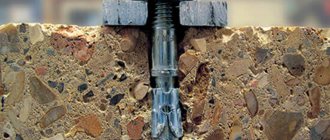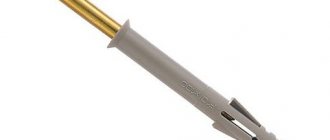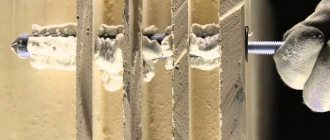Anchor fasteners have different modifications; they are designed for strong and reliable fastening of equipment, suspended structures, stairs, lamps and other objects. Today we will find out what a frame anchor is used for - a universal fastener with a simple design. It differs from other anchor fasteners in a number of characteristics that should be taken into account when choosing and using it.
Anchor - classification and scope of use
According to unconfirmed statistics, it is believed that Russia is capable of absorbing about 15 thousand tons of all kinds of anchors in one quarter, which is only three months. Our mounting element is almost at the top of this list. This is explained simply: this type of fastener is made so popular by its technical characteristics and a fairly wide range of applications.
But initially, such fasteners were intended for attaching window frames and door frames to a concrete and brick base. It is thanks to its purpose that such a dowel received the “frame” classification. Today, fasteners correspond to their immediate technical characteristics, and most of this type of dowels is used for installing metal-plastic windows and door frames made of various materials.
But thanks to its versatility, the use of the anchor did not end with the above tasks. As it turned out, such fasteners were ideal for mounting wooden beams and slats to various bases. For example, it is very convenient to use such an anchor when installing a wooden beam when installing a floor on a small area; in practice, it could be an ordinary balcony block, the floors of which you want to make of wood.
Plastic anchors HILTI
HRV-H Plastic frame anchor HILTI with hexagonal head
Anchor type HRV-H HILTI : Plastic anchor.
Head type: Hex head. Suitable for concrete and solid bricks. Available in hot-dip galvanized finish for use in a variety of aggressive environments. Built-in plastic and steel washer.
HRV-HF HILTI plastic frame anchor with hexagonal head (hot-dip galvanized)
Anchor type HRV-HF HILTI : Plastic anchor. Head type: Hex head.
Suitable for concrete and solid bricks. Hot-dip galvanized version for use in various environments. Built-in plastic and steel washer.
HRD-H HILTI frame anchor with hexagonal head
Anchor type HRD-H HILTI: Anchor with screw. Head type: Hex head. Mounting method: Through fastening.
Flexible insertion depth (permissible range 50-70 mm) - HRD-H HILTI is the ideal anchor for a wide range of applications for almost all base materials. Suitable for installation of products up to 150 mm thick (anchor length varies from 60 mm to 200 mm). Manufactured from 4 different materials for use in all corrosive environments. Pre-assembled for ease of operation and improved fastening quality.
HRD-HF HILTI frame anchor with hexagonal head
Anchor type HRD-HF HILTI: Anchor with screw. Head type: Hex head. Mounting method: Through fastening.
Flexible insertion depth (allowable range 50-70mm) is the ideal anchor for a wide range of applications for almost all base materials. Suitable for installation of products up to 150 mm thick (anchor length varies from 60 mm to 200 mm). Manufactured from 4 different materials for use in all corrosive environments. Pre-assembled for ease of operation and improved fastening quality.
Application of HRD-HF HILTI : Installation of brackets for ventilated facades. Typical applications for metal fabricators include the installation of railings, window grilles, railings, parapets, etc.
HRD-HR HILTI frame anchor with hexagonal head
Anchor type HRD-HR HILTI: Anchor with screw. Head type: Hex head. Mounting method: Through fastening.
Flexible insertion depth (allowable range 50-70mm) is the ideal anchor for a wide range of applications for almost all base materials. Suitable for installation of products up to 150 mm thick (anchor length varies from 60 mm to 200 mm). Manufactured from 4 different materials for use in all corrosive environments. Pre-assembled for ease of operation and improved fastening quality.
Application of HRD-HR HILTI: Installation of brackets for ventilated facades. Typical applications for metal fabricators include the installation of railings, window grilles, railings, parapets, etc.
HRD-HR2 HILTI frame anchor with hexagonal head
Anchor type HRD-HR2 HILTI: Anchor with screw. Head type: Hex head. Mounting method: Through fastening.
Flexible insertion depth (allowable range 50-70mm) is the ideal anchor for a wide range of applications for almost all base materials. Suitable for installation of products up to 150 mm thick (anchor length varies from 60 mm to 200 mm). Manufactured from 4 different materials for use in all corrosive environments. Pre-assembled for ease of operation and improved fastening quality
Application of HRD-HR2 HILTI: Installation of brackets for ventilated facades. Typical applications for manufacturers of metal structures, such as installation of railings, window grilles, fences, parapets, etc.
HRD-C HILTI frame anchor with countersunk head
Anchor type HRD-C HILTI : Anchor with screw. Head type: Concealed head. Mounting method: Through fastening.
Flexible insertion depth (allowable range 50-70mm) is the ideal anchor for a wide range of applications for almost all base materials. Suitable for installation of products up to 260 mm thick (anchor length varies from 60 mm to 310 mm). Manufactured from 3 different materials for use in all corrosive environments. Pre-assembled for ease of operation and improved fastening quality
Applications of HRD-C HILTI: Typical applications for steel structure manufacturers, such as installation of railings, window grilles, fences, parapets, etc. Installation of wooden supports for ventilated facades. Installation of window and door frames.
HRD-CR HILTI frame anchor with countersunk head
Anchor type HRD-CR HILTI : Anchor with screw. Head type: Concealed head. Mounting method: Through fastening.
Flexible insertion depth (allowable range 50-70mm) is the ideal anchor for a wide range of applications for almost all base materials. Suitable for installation of products up to 260 mm thick (anchor length varies from 60 mm to 310 mm). Manufactured from 3 different materials for use in all corrosive environments. Pre-assembled for ease of operation and improved fastening quality.
Applications of HRD-CR HILTI: Typical applications for steel structure manufacturers, such as installation of railings, window grilles, fences, parapets, etc. Installation of wooden supports for ventilated facades. Installation of window and door frames.
HRD-K HILTI frame anchor with hexagonal head
Anchor type HRD-K HILTI : Anchor with screw. Head type: Hex head. Mounting method: Through fastening.
Flexible insertion depth (allowable range 50-70mm) is the ideal anchor for a wide range of applications for almost all base materials. Suitable for installation of products up to 90 mm thick (anchor length varies from 60 mm to 140 mm). Made from carbon steel and A2 stainless steel. Pre-assembled for ease of operation and improved fastening quality
Application of HRD-K HILTI: Installation of brackets for ventilated facades. Typical applications for metal fabricators include the installation of railings, window grilles, railings, parapets, etc.
HRD-KR2 HILTI frame anchor with hexagonal head
Anchor type HRD-KR2 HILTI : Anchor with screw. Head type: Hex head. Mounting method: Through fastening.
Flexible insertion depth (allowable range 50-70mm) is the ideal anchor for a wide range of applications for almost all base materials. Suitable for installation of products up to 90 mm thick (anchor length varies from 60 mm to 140 mm). Made from carbon steel and A2 stainless steel. Pre-assembled for ease of operation and improved fastening quality
Application of HRD-KR2 HILTI: Installation of brackets for ventilated facades. Typical applications for metal fabricators include the installation of railings, window grilles, railings, parapets, etc.
HRD-P HILTI frame anchor with hexagonal head
Anchor type HRD-P HILTI : Anchor with screw. Head type: Round head. Mounting method: Through fastening.
Flexible insertion depth (allowable range 50-70mm) is the ideal anchor for a wide range of applications for almost all base materials. Manufactured from 2 different materials for use in all corrosive environments. Pre-assembled for ease of operation and improved fastening quality.
Applications of HRD-P HILTI: Typical applications for metal fabricators such as the installation of railings, window grilles, railings, parapets, etc.
HRD-PR2 HILTI frame anchor with hexagonal head
Anchor type HRD-PR2 HILTI : Anchor with screw. Head type: Round head. Mounting method: Through fastening.
Flexible insertion depth (allowable range 50-70mm) is the ideal anchor for a wide range of applications for almost all base materials. Manufactured from 2 different materials for use in all corrosive environments. Pre-assembled for ease of operation and improved fastening quality
Applications of HRD-PR2 HILTI: Typical applications for metal fabricators such as the installation of railings, window grilles, railings, parapets, etc.
HRD-UGT 14 HILTI Universal plastic frame anchor
Anchor type HRD-UGT 14 HILTI : Anchor with screw. Head type: Concealed head. Mounting method: Through fastening.
Universal frame anchor for a wide range of different base materials. Unsurpassed ease of installation. Strong and reliable anchor.
Application of HRD-UGT 14 HILTI: Through installation of structures made of metal, aluminum and wood. Mainly used for installing facade, window and door frames and other through-hole installations, such as fastening wooden beams.
HRD-UGS 14 U Frame anchor HILTI
Anchor type HRD-UGT 14 U HILTI: Anchor with screw. Head type: Hex head. Mounting method: Through fastening.
Built-in plastic washer to prevent contact corrosion. Built-in steel press washer to ensure quality installation. Reliable installation in a wide range of base materials. Min. planting depth - 70 mm (concrete and hollow brick). The plastic press washer prevents contact corrosion between different materials, such as steel and aluminum.
Application of HRD-UGT 14 U HILTI: Installation of brackets for ventilated facades. Typically used in the installation of metal structures, for example, for installing handrails, window grilles, fences, balustrades and various decorative steel elements.
HUD-1 Universal plastic anchor HILTI
Type of anchor HUD-1 HILTI : Plastic anchor. Head type: No. Fastening method: Pre-fastening, Through fastening.
HUD-1 HILTI is suitable for use in various materials: concrete, hollow and solid bricks, aerated concrete (cellular), gypsum panels. High loads. Suitable for installation through already installed parts. Without turning in the hole during installation and premature wedging.
Reliability: precise screw direction, 360° wedging.
A wide range of installation works for the installation of structures with low loads, in particular, electrical wiring, sanitary equipment, etc.
HUD-L Universal plastic anchor HILTI
Type of anchor HUD-L HILTI : Plastic anchor. Head type: No. Fastening method: Pre-fastening, Through fastening.
Extended length for connecting thick layers of plasterboard (up to 30 mm). Forms a “knot” after installation in hollow materials and drywall. Full control of screw driving, without damaging the plastic anchor or moving to the side. Special shape to reduce rotation and secure installation in the hole, with the tip wedging in four directions. Possibility of using standard commercially available screws (see technical information).
Applications of HUD-L HILTI: Restoration work on surfaces covered with a thick layer of gypsum and also fastening to plasterboard panels, for example, for the installation of junction boxes, cables, switches, lighting fixtures, brackets, shelves, plumbing fixtures, wall brackets, etc.
Plastic anchor HUD-L HILTI of increased length for restoration and restoration work, suitable for installation of drywall.
HDS-C-TX Countersunk Torx Head HILTI
Head type HDS-C-TX HILTI : Countersunk Torx head
Full length carving. Comfortable handle with Torx tip. Compatible with various plastic anchors. Neat finish with countersunk head.
Application of HDS-C-TX HILTI: Electrical components: fastening of lighting equipment, cable trays, control units, clamps, motion sensors. Mechanical components: fastening of vanities, toilets, towel holders, bathroom fixtures, mirrors. Various fastenings for light loads.
HDS-P-TX Torx head screw HILTI
Head type HDS-P-TX HILTI : Round head.
Full length carving. Comfortable handle with Torx tip. Compatible with various plastic anchors.
Application of HDS-P-TX HILTI:
Electrical components: mounting of lighting equipment, cable trays, control units, clamps, motion sensors. Mechanical components: fastening of vanities, toilets, towel holders, bathroom fixtures, mirrors. Various fastenings for light loads.
HPS-1 Dowel nail HILTI
Anchor type HPS-1 HILTI : Plastic anchor. Head type: Countersunk head with cross slot. Mounting method: Through fastening.
For universal use on many materials including perforated bricks and blocks. The driving screw can also be screwed in or out using a screwdriver. Quick installation of HPS-1 dowel-nail HILTI using a hammer.
Application of HPS-1 HILTI: Installation of finishing strips, battens and components of electrical equipment and pipelines.
HLD Anchor for low loads HILTI
Anchor type HLD HILTI : Plastic anchor. Head Type: Flat Head, Round Head. Fastening method: Pre-fastening, Through fastening.
Unique anchor opening and can be used in all base materials. Various types of screws can be used.
Application of HLD HILTI: Fastening in hollow materials with low strength, standard wood screws are suitable. Installation in hollow bricks and blocks, plasterboard and concrete.
Frame metal anchor - making the right choice
Let us assume that you have already decided for what purposes you need fasteners, and now all that’s left is to buy the necessary part and carry out installation. But the choice of mounting bolts is also a crucial moment, especially since currently there are a large number of low-quality products, and if this concerns anchor fasteners, then we definitely need to take into account some points, namely:
- The material from which the fastener is made. The anchor can be made of various metals, as a rule, it can be ordinary steel, galvanized steel, stainless steel, and also brass. Depending on the application environment, you need to select the appropriate fastener.
- Hairpin length. In each individual case, the length is determined based on the tasks that the fastener must perform.
- Spacer quality. This is perhaps the main technological parameter of the entire fastener. The thickness of the bushing, based on existing requirements, must be at least 0.8 millimeters, and if the thickness of the metal of the bushing is less, you risk getting a poor-quality fastening.
Operating principle and design features
The technical capabilities of a frame anchor are determined by the features of its design. When choosing a frame metal anchor for installation work, you should take into account the fact that it is not designed for significant loads and the large weight of objects secured with it. The weight of an object fixed on a vertical surface using one anchor of this type cannot exceed 30 kg.
Frame anchor device
The main structural element of a frame anchor bolt is a metal sleeve with longitudinal slots that form peculiar petals that open during installation of the fastener. A cone nut is responsible for opening the petals on the side of the bushing. It, screwed onto the main rotor, acts on the inner surface of the sleeve with slots, thereby unclenching it. The bushing, having increased in diameter, engages tightly with the inner walls of the mounting hole, securely locking into it.
To make it more convenient to manipulate the screw screwed into the spacer sleeve, there is a head with slots for a shaped screwdriver on its upper part. A special feature of the frame anchor is that its head is completely recessed into the mounting hole, so the side surface of its head has a conical shape. When using such fasteners, you should not only drill holes for their placement, but also provide a special “sunk hole” into which the bolt head will fit.
The use of screwdrivers with a shaped working part for installing frame anchors makes this process convenient and allows it to be carried out effectively even in hard-to-reach places.
The frame anchor for hollow structures has an enlarged spacer zone (butterfly) and a flat-shaped nut that works to tighten
Rules for mounting the fastening element
Let's now look at the basic rules for installing our dowel using a specific example. After all, compliance with all technical conditions for installing the anchor determines how the structural element we have secured in the future will hold, be it a door frame or a wooden beam on which we are going to hang a heavy carpet. First of all, we need to prepare the tool with which we will carry out the installation.
To do this, we will take a hammer drill, a drill for it, with a diameter of 8 millimeters, and we will also need a Phillips screwdriver to tighten the fastening pin, and also prepare a hammer, we cannot do without it. As an example, we will look at installing a window frame and then using our frame fasteners. So, let’s get started and go through all the steps of installing a window unit step by step.
How to attach?
To install a frame or door jamb, in addition to a set of anchors, you cannot do without some tools:
- a hammer drill with a set of drills for drilling wall material and for drilling a hole in a metal structure;
- hammer;
- a Phillips screwdriver or a corresponding bit for installation on a screwdriver; some craftsmen make do with the same hammer drill in drill mode at low speeds;
- building level;
- pencil.
Fastening the frame with anchors step by step is as follows.
- The frame must be wedged in place, making sure to adjust the vertical and horizontal levels. Wedges can be wooden or plastic. To install them you will need a hammer.
- Marking the frame for holes. It is customary to drill at a distance of 30 cm from the corners, but this is not an unshakable truth; sometimes you have to take into account the features of the wall and change the standard distances; as a rule, this does not affect the quality of the frame installation. In the places chosen for drilling, it is necessary to make a countersunk hole for the anchor head.
- Holes are drilled in the designated locations. Next, after changing the drill, you need to drill through the wall material to a depth sufficient to install the fasteners.
- Clean the drilled hole, removing debris, dust and splinters of material.
- Insert the anchor into the drilled hole. You may have to use a hammer, but this should be done without excessive force.
- Use a Phillips screwdriver or bit to tighten the anchor.
- When installing the next anchor, check the position of the frame with a level - if no displacement has occurred, perform all the operations described above.
To install a small fixed frame with a side of less than 1 m, 4 dowels are sufficient. Typically, to install frames, two anchors are used on each side of the frame.
In the next video you will find examples of installation of various anchors.
How to properly install the fastening element - step-by-step diagram
Step 1: Install the frame into the opening using spacers
Before you start drilling holes and permanently securing the window block, the frame itself must be correctly positioned on spacers, align the window block relative to the vertical plane and, accordingly, the horizontal one. To do this, we use pads under the frame and wedge the frame on both sides with wedges. We hammer the wedges in as tightly as possible so that the frame stands firmly in the window opening. The building level will help us check the evenness. If deviations are observed, then with light blows of a hammer we remove these defects, moving the frame in the desired direction.











